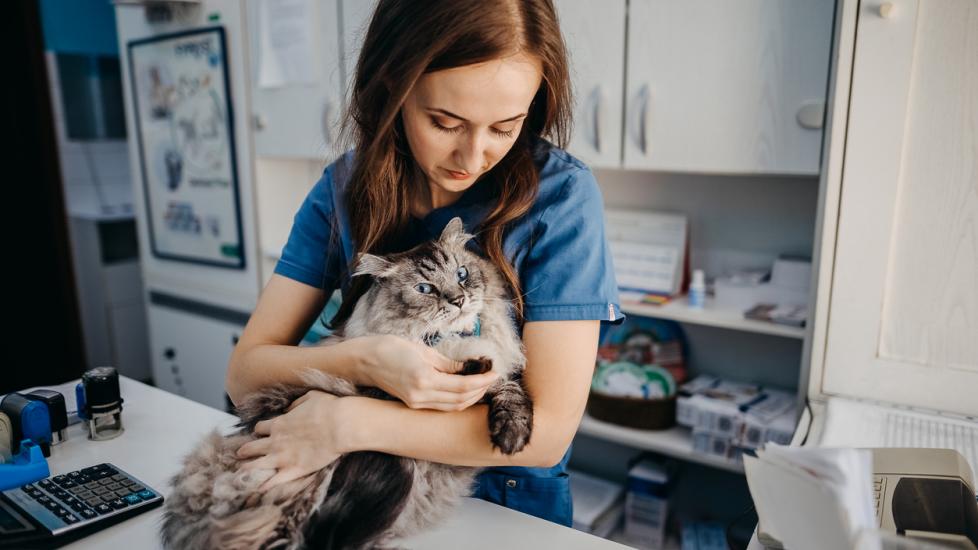When to Put a Cat With Hyperthyroidism to Sleep
Hyperthyroidism is the most common hormonal disease that affects cats. It’s almost always caused by a non-cancerous overgrowth of thyroid tissue, which leads to an overproduction of thyroid hormone.
The important thing to know is that hyperthyroidism is not a death sentence! Most hyperthyroid cats do very well and can live another 5 years or more when they receive appropriate treatment. However, some cats continue to have health problems or even develop new ones as time goes on.
Monitoring the quality of life for a cat with hyperthyroidism is very important, so you’ll know when to talk to your veterinarian about additional treatment or euthanasia.
What Is the Life Expectancy of a Cat With Hyperthyroidism?
After diagnosis, a cat’s life expectancy depends on many factors. One study found that cats who were treated with methimazole followed by radioactive iodine (I-131) typically lived for another 5.3 years. This is impressive, considering that cats who develop hyperthyroidism are usually 12-13 years old at the time of diagnosis.
The reason cats can live long and happy lives after being diagnosed with hyperthyroidism is in part due to several good treatment options:
-
Anti-thyroid medications—Methimazole interferes with the production of thyroid hormone. The right dose will usually bring a cat’s thyroid hormone levels back to normal. This drug is designed to be given orally, but it can be reformulated into a gel that is absorbed through the skin of a cat’s ears. Many pet parents find it easier to rub gel on their cat’s ears than try to give them pills every day.
-
Low-iodine cat food—Cats need iodine to make thyroid hormone. Feeding a cat a therapeutic food that has very low iodine levels is an easy way to manage hyperthyroidism.
-
I-131 therapy—Radioactive iodine (I-131) given by injection kills off abnormal thyroid tissue. I-131 therapy can cure a cat of hyperthyroidism. Your cat will spend a few days in the hospital, and you’ll be given instructions on how to safely care for them and handle their litter and litter box while they continue recovering at home.
The surgical removal of abnormal thyroid tissue used to be a popular form of treatment for hyperthyroidism in cats, but I-131 therapy has largely replaced it because it is safer and more effective.
Vet Recommended Health Support
Early Signs of Thyroid Disease in Cats
It’s best to diagnose hyperthyroidism as early as possible. This is when treatment is at its most effective and least expensive. Early signs of hyperthyroidism typically include:
-
A scruffy appearance
-
Hyperactivity and other behavioral changes
-
Increased thirst and urination
Signs of Untreated Thyroid Disease in Cats
Left untreated, hyperthyroidism can lead to high blood pressure, heart disease, respiratory problems, kidney disease, liver problems, skin conditions, weakness, tremors, and blindness.
Because hyperthyroid cats are typically older, many may also have some degree of chronic kidney disease. In fact, improving a cat’s hyperthyroidism may uncover the presence of chronic kidney disease, which complicates treatment.
Here are some signs that a cat has moderate to severe hyperthyroidism that is not well-controlled. Call your veterinarian immediately if you notice any of these symptoms:
-
A gaunt appearance
-
Dramatically increased thirst and urination
-
Severe vomiting or diarrhea
-
Seizures
-
Collapse
It’s also possible for the treatment of hyperthyroidism to go too far. The goal of therapy is to get a cat’s thyroid hormone levels back into the normal range. If they fall too low, the cat can develop hypothyroidism, or low thyroid hormone levels. Most of these cats have no clinical signs, but a few will develop symptoms like lethargy, poor appetite, weight gain, and skin and coat problems. Their thyroid hormone levels often return to normal with time, but they can be given supplemental thyroid hormone if necessary.
When to Euthanize a Cat With Hyperthyroidism
Treatment for hyperthyroidism is usually very effective, even when it is started relatively late in the course of the disease. There’s no need to rush to euthanasia when there are so many good treatment options available.
Some, like I-131 therapy, are quite expensive, but will often cure hyperthyroidism altogether, so you won’t have the ongoing cost of a special food or medications. Other options are very cheap. Generic methimazole is available by prescription for just a few cents a pill.
Cats with hyperthyroidism are often euthanized because they develop other health problems later in life, such as kidney disease or cancer.
Monitoring your cat’s quality of life is important, as with any pet, particularly as they get older. Filling out a pet quality of life scale assessment regularly can help you pick up on problems earlier than you might otherwise. In general, a cat’s quality of life is poor when:
-
They are having persistent problems eating, drinking, peeing, pooping, or getting around.
-
They don’t interact normally with the family or partake in activities that they used to enjoy.
-
They have more bad days than good.
Talk to your veterinarian if you have any concerns about your cat’s health or well-being. They can talk to you about what treatment options are appropriate, based on the specifics of your cat’s case. Or, if your cat is suffering and further treatment is unlikely to be successful, they can help you with the decision to euthanize.
Featured Image: iStock/eclipse_images
